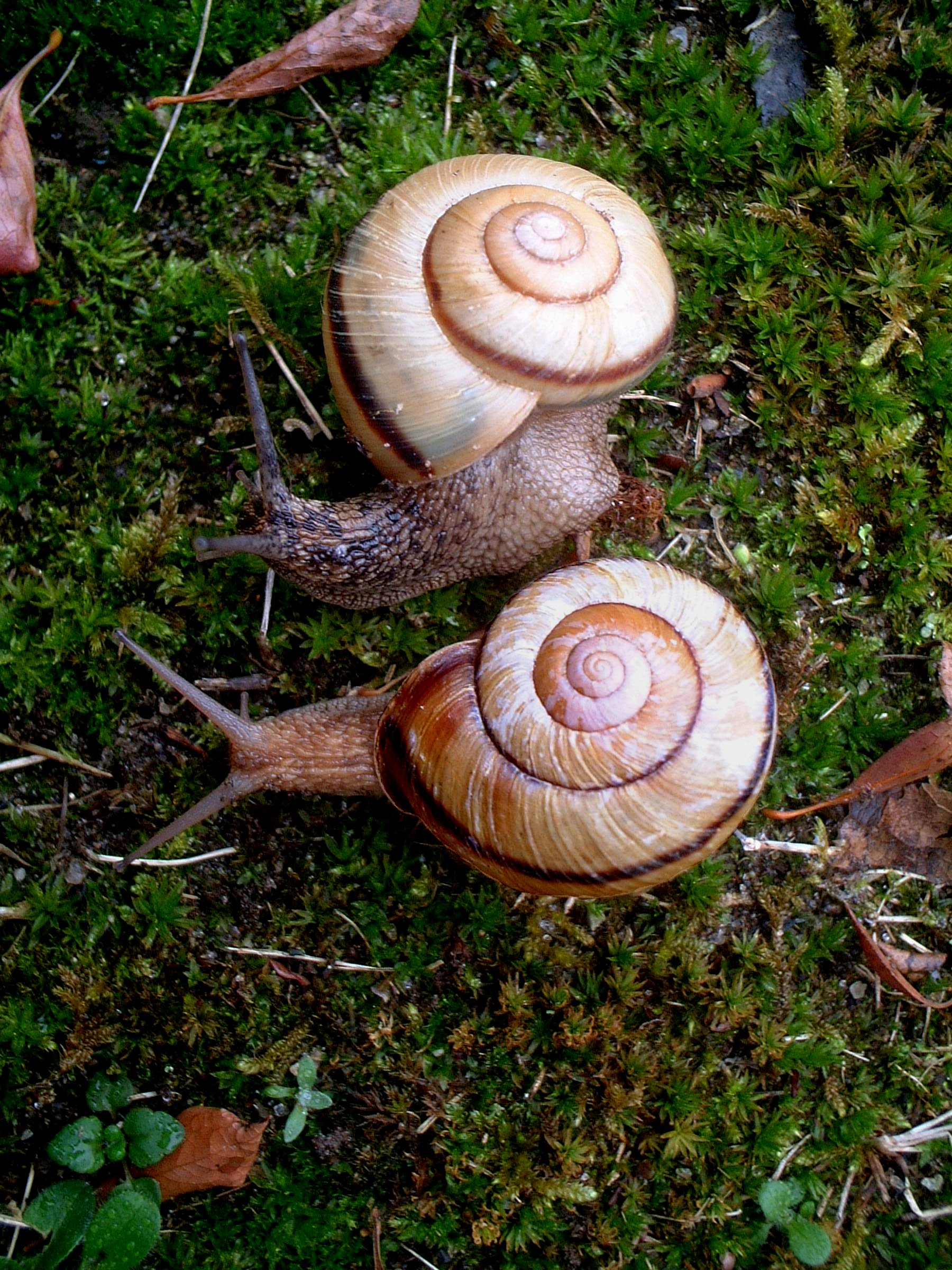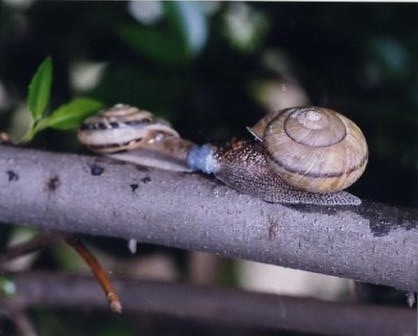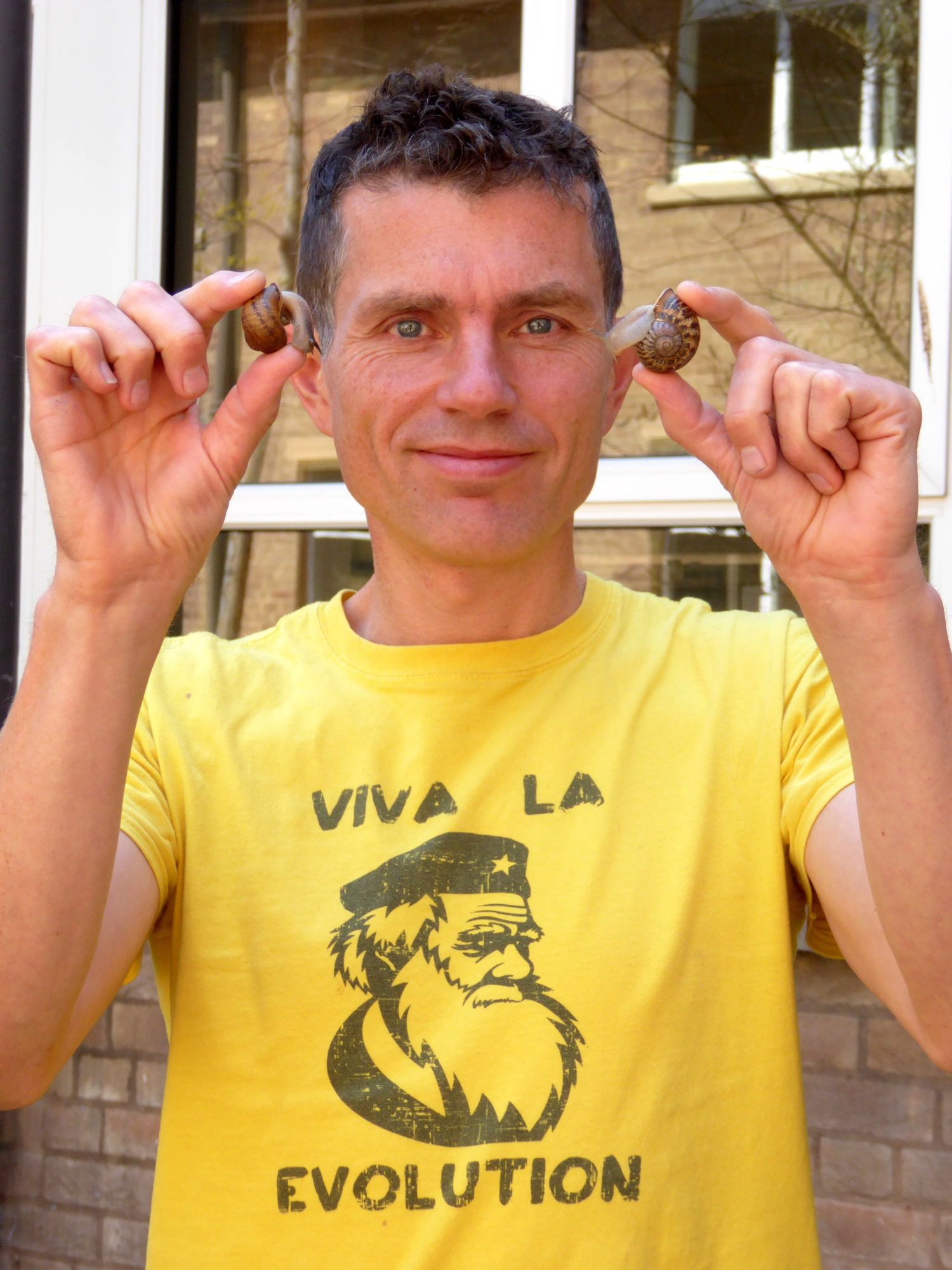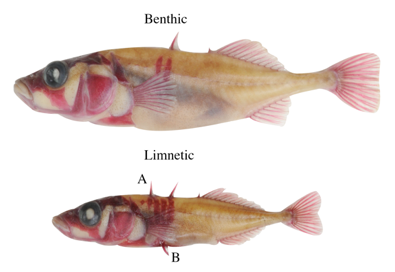A new study in Evolution Letters has shown that two types of snails are the same species, despite previously being considered distinct because their shells coil in the opposite direction. Not only are the snails genetically similar, but surprisingly, they are able to have sex despite their physical differences. Here Dr Angus Davison, one of the study’s authors, tells us more about twisted snail sex and its evolutionary implications.

EL: One of the key findings of your study was that some mirror-image snails, which coil in different directions due to the effects of a single gene, can have sex despite being rather misaligned. How does that work?
AD: Most land snails with low spired snails – including garden snails and Cepaea – mate in a face-to-face position, and are simultaneous hermaphrodites, so mate as male and female at the same time. In normal right-coiling snails (dextrals), the genitals are on the right hand side of the head, so that when two snails mate, the two right sides come together, and their genitals are inserted reciprocally.
If a common dextral snail meets a rare sinistral ‘lefty’ snail, the snails try to mate as normal – but the parts don’t fit together as expected. You could liken it to trying to shake a left hand, everything is in the wrong position and it is very awkward. A further analogy might be to think of that scene in films where car-driving drug dealers meet in a parking lot to exchange packages, by winding down their windows and reaching across. This only works if they are both in right-hand or left-hand drive cars. The same may be true for snails, except of course they are trading spermatophores, rather than drugs.
EL: Why do they have to mate face-to-face?
AD: That is a great question! I think that the key point is that in face-to-face mating, copulation only takes place if actions are reciprocated, meaning that both mating partners are obliged to act as male and female at the same time. I think that for these snails – as in humans – maintaining mutual communication probably works best in a face-face position
Some other snails mate in a different position: one snail mounts the other from behind and takes a male role, with the other being female. After a first mating, they may reverse the process and switch sex roles – but there is no obligation.

EL: We often claim that opposites attract, but these tricky sexual encounters sound off-putting. Do these snails generally prefer to have sex with similarly coiled mates?
AD: The limited evidence that we have suggests that while a snail has knowledge of its own chirality, because of the chiral movements that they make during courtship, I don’t think that they can sense the coiling direction of another snail. This is probably what leads to the fumbling that we see when lefties and righties try to mate – they will try repeatedly, but without success. Unfortunately, we have almost no data on mating frequencies, partly because encounters between lefties and righties are so rare.
In snails such as the garden snail, and Japanese Euhadra, it has been commonly assumed that dextral and sinistral are not able to mate, arguably making them separate species. One consequence of not being able to mate is that the rarer type of snail will tend not to have offspring and so the underlying chirality-determining allele will not be passed on. This frequency-dependent selection partly explains why most snails only coil one way, and why closely related but differently coiling Euhadra do not occur together, except in narrow contact zones, across Japan. However, the other interesting part of the explanation for the dominance of one type of snail is that mutations at the chirality gene locus can affect several different traits at once (pleiotropy). This means that it is simply very difficult to change chirality without making deleterious changes to other characteristics of the snails, especially during early development.
Finally, we might suppose that the reason sinistrals and dextrals are not able to mate is because the genitals don’t fit together in a physical sense. However, Menno Schilthuizen has shown in Amphidromus snails that it is more a behavioural issue. As the genitals are long, thin, flexible organs, it is not a problem for them to twist into position – it is just that the snail does not know how to do this, because it is not aware of the problem in the first place.
EL: Your work challenges the previous consensus that certain mirror-image snails constitute different species. Animals are generally considered to be the same species if they can produce viable offspring, not just if they can physically copulate. Do your mirror-image snails reproduce successfully?
AD: We have no direct evidence that the left and right coiling Euhadra that we studied are able to produce viable offspring when they do occasionally mate. However, the evidence is in the DNA – we used a technique called Restriction site Associated DNA sequencing (RAD-seq) to survey their genomes, which confirmed that there is movement of genes between the two types.
As a geneticist, the interesting aspect of this study is that the expression of the snail chirality gene is delayed by a generation, due to ‘maternal inheritance’, famously first described in the 1920s. In a similar way that the shell colour of a bird’s egg is determined by the mother, rather than the offspring inside the egg, the early embryonic switch to dextral or sinistral, and the later coiling direction of a snail, is determined only by the mother. One curious consequence of this maternal inheritance is that it can lead to disconnect between phenotype and underlying genotype, so a snail with a dextral coiling shell might be genetically homozygous sinistral, and thus bear sinistral offspring. This discord is a further indirect route by which the two types exchange genes.
Our final conclusion, which I hope others agree with, is that changes in chirality are insufficient on their own to cause speciation – other factors are required.
EL: Does the direction in which a snail coils impact any other aspect of its life, other than who it can mate with?
AD: Previously, we found a mutation in pond snails which determines whether they coil to the left or right, but in that species the mutant sinistrals have a poor hatch rate compared with dextrals, making it unlikely that they will ever reach a high frequency – so this mutation is not important in an evolutionary sense. For me, the most fascinating thing would be to find the genes that determine the differences in chirality in species such as Euhadra, perhaps via a genome wide association study (GWAS) which would allow us to find genetic variants that are associated with this particular trait. The interest is precisely because the chiral switch has no other impact upon these snails’ lives.
EL: Are there any other animals in which body plan asymmetry can be reversed? What are the consequences?
AD: The amazing thing is that no other animals commonly vary in their asymmetry, except perhaps a few nematodes. Why? I think that it again comes down to pleiotropy (when a gene influences multiple seemingly unrelated traits) – it is simply very difficult to reverse asymmetry without making other deleterious changes. At this moment, it is not clear why snails are able to vary their chirality, nor which genes are involved in making these changes – but I would love to find out.
Ultimately, these studies may have some consequence in understanding human development – although only about one in ten thousand persons is a mirror-image internally (including Enrique Iglesias and Donny Osmond), organ positioning defects are a relatively common cause of pre-term loss of embryos. Although studying snails is not going to cure any problems caused by positioning defects, longer term research will contribute to an understanding of the establishment of left-right asymmetry, especially in finding commonalities in the development of these diverse organisms.

If these snails are a single species, how did the two mirror-image types arise in the first place? Which one came first?
A chicken and egg question – but one which we can probably answer! Although snails have switched chirality multiple times, the vast majority of snail species are still right-coiling (or dextral). My guess is that the very first snail to become established was right coiling, and it is simply difficult to change.
There are some clues as to why it might sometimes be an advantage to change chirality, despite the difficulties. One explanation is that being sinistral means that a snail does not have unproductive matings with closely related species living in the same geographical area – such may be the case in Euhadra. Another intriguing explanation, provided by a colleague Masaki Hoso, is that being sinistral reduces the chance of being predated by a snake, which fits with the observation that there is a relatively high proportion of sinistral snails in East Asia where the snake is found.

Dr Angus Davison is Associate Professor and Reader in Evolutionary Genetics at the School of Life Sciences, University of Nottingham. The study is freely available to read and download via Evolution Letters Early View.

